Description of varieties of peppers Big Papa, East Star, Purple Bell, Blot, Purple
Sweet varieties of peppers are demanding on growing conditions, a significant part of them need sufficient heat and a long growing season. Against the background of existing varieties, such new varieties as Big Papa pepper, Eastern Star, Purple Bell and Blot are favorably distinguished.
Unlike most large types of peppers, the listed varieties have rich taste characteristics and are not bitter. The unique combination of taste characteristics of peppers with high yield rates determines their popularity in our country. The varieties attract fans of the unusual because of their unique color scheme.

The agrotechnics of working with sweet peppers practically does not differ from standard varieties. The cultivation is carried out in a seedling manner, and the planting time is determined depending on the desire for the harvest. Peppers are bad for numerous transplants, are demanding on watering and soil nutrition. Lack of heat and light negatively affects the yield of sweet peppers.
Big Daddy
Sweet pepper is intended for cultivation in greenhouses and in open field conditions. A distinctive feature of the hybrid species is the unusual color of the plant's fruits, which at the initial stage acquire a lilac hue, and by the end of fruiting, a bright saturated purple color.
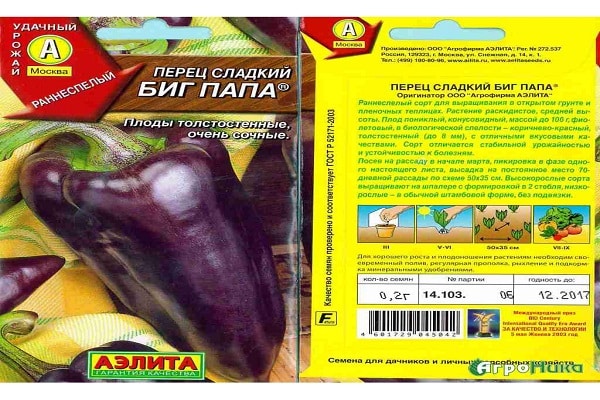
The plant is grown in seedlings and after planting, the seeds germinate early. The landing time is determined in such a way that 80 days have passed before the transfer to a permanent place. After the appearance of the first shoots, it takes from 96 to 104 days before the first pepper ripens.
The height of the bush does not exceed 60 cm. It is recommended to plant seedlings according to the scheme of 50 cm between bushes and a distance of 35 cm between rows.
Purple pepper does not differ in its large size, its average length reaches 8 cm and a width of 5 cm. The weight of one vegetable is from 90 to 120 grams. During the flowering period, the plant pleases gardeners with beautiful lilac small flowers. Despite the average weight and size of fruits, the variety shows a high yield and from 1 m2 with proper care, remove up to 8 kg of vegetables.
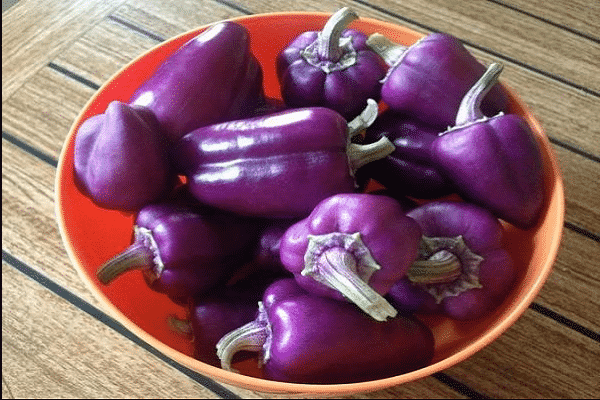
Star of the east
Pepper Star of the East, thanks to the efforts of breeders, has a wide range of varieties of a wide variety of colors. They differ slightly in fruit size and yield indicators, but the main property of all types of the variety is the combination of sweet taste and juiciness of the fruit. Gardeners' reviews compare the taste of vegetables with the famous southern types of peppers. The fruits are used for eating fresh and in recipes for winter preparations, giving them an original appearance, rich taste and smell.
At the moment, breeders have bred several hybrid varieties of the Star of the East variety. Each of them has a unique color, due to which the type of pepper got its name. The series got its name because of the characteristic feature of the pepper, which resembles a star when sliced.
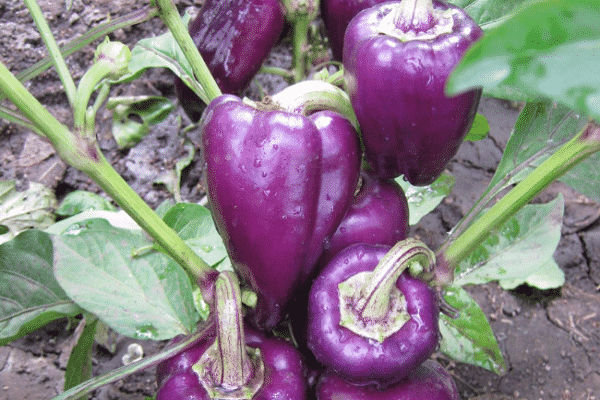
Characteristics and description of the series:
- Purple - fruit weight 180-300 grams, walls up to 7 mm, yield from 6 to 7 kg per 1 m2, at the end of the growing season, the color can become dark cherry hue.
- Chocolate - fruit weight 270-350 grams, yield 10 kg from 1 m2.
- Golden - pepper weight 175-200 grams, yield 7.5 kg from 1 m2, a distinctive feature is the simultaneous ripening of vegetables.
- White, White in red, Red - fruit yield up to 8 kg from 1 m2... A light color is observed at the beginning of the period; at the end of ripening, vegetables acquire a dark yellow color, a shade of red or red, depending on the species.
- Mandarin - shows the rate of return of the crop from 8 to 9 kg from 1 m2, the mass of pepper reaches from 250 to 290 grams.
- Yellow, Orange - the species differ only in the color of the fruits, the average weight of one fruit varies from 160 to 180 grams, some vegetables can reach a weight of 250 grams.
- Giant - the weight of the pepper is 400 grams, it is distinguished by the high growth of bushes and a large number of fruits on the plant in an amount of 7 to 10 pieces.
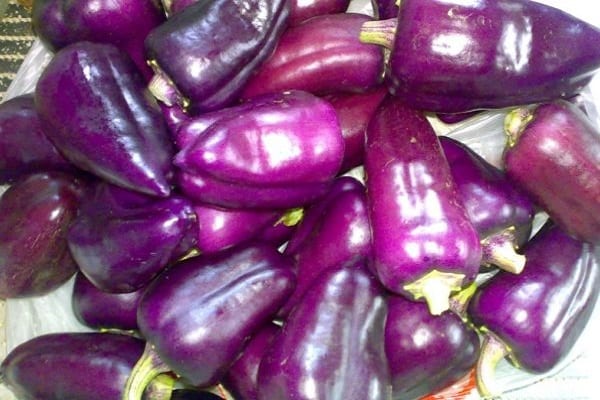
In the early stages, all fruits are light in color, which begins to change during the ripening of the fruit. Due to this feature, vegetables of several colors can be simultaneously observed on one bush. The peppers are large and cubic in shape. The average wall thickness, depending on the type, varies from 5 to 10 mm.
The variety can be attributed to the early maturing species, since the ripening period of the bulk of the species is from 105 to 115 days. The exception is the Giant and Chocolate Star, since the first fruits are obtained in 120-130 days. The advantage of the variety is the ability to grow under conditions of street care and in greenhouse shelters. In the northern regions, it is recommended to adhere to planting under a film, otherwise the fruiting period may be delayed, and the yield indicators can decrease significantly.

Pepper bushes form powerful and are particularly hardy. The average height reaches 60-80 cm. The species of the Orange and Yellow Star stand out, which in greenhouse cultivation are capable of reaching a height of more than 1 meter. This feature affects the yield indicators. If for the bulk of the hybrid variety, it is 5.8-11 kg of vegetables from 1 m2, then for these two species it reaches 18-24 kg.
The variety compares favorably with other hybrid varieties in immunity to tobacco mosaic and wilting of the verticillium species. Unripe fruits are able to gain strength at home without loss of taste.

Purple bell
Sweet Pepper Purple Bell is a medium-ripening variety. The popularity of the species is associated with the unusual appearance and taste of the fruit. Gardeners choose the Purple Bell variety because of the rich taste characteristics and the unusual almost black color of the fruit.
The plant is intended for growing in outdoor conditions and in greenhouse structures, with the latter option, the yield indicators and the size of the fruits grow. When grown outdoors, the average growth of the bushes reaches 70-80 cm. The advantage of the variety is resistance to tobacco mosaic and potato virus.
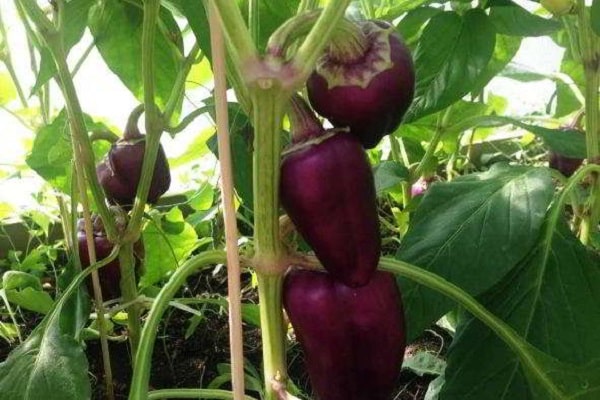
The plant's advantage is the ability to withstand temperature changes and show high yields when grown in difficult climatic conditions. The cultivation is carried out in seedlings.The plant does not treat transplants well, therefore, when carrying out such work, the growth of shoots is suspended. From the time of germination until the appearance of the first mature pepper, it takes from 75 to 80 days. The recommended planting pattern is 40 by 60 cm.
With the correct growing technique and adherence to the basic rules of growing from 1 m2 remove up to 8 kg of peppers.
Pepper fruits weigh up to 165 grams. Vegetables have a characteristic cuboid shape and are characterized by a small wall thickness, which reaches 6 mm. The parameters of height and diameter are on average 9 to 11 cm. A distinctive feature of the variety is the presence of a pronounced peppery taste, juiciness and aroma in vegetables. The fruits can be used fresh and for making homemade preparations.
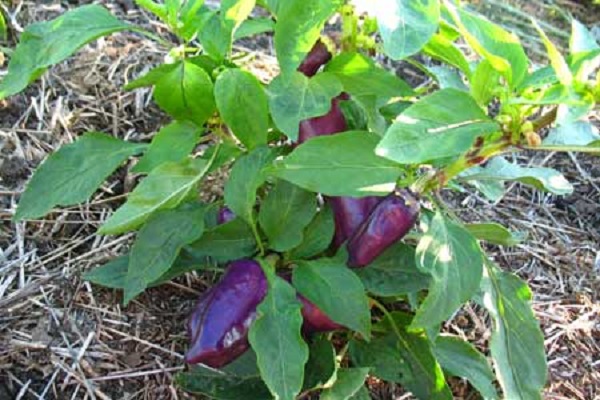
Blot
The description of the variety classifies the sweet representative of purple varieties as a medium-ripening species. The bushes of the plant are distinguished by their low height and weak spreading of the brushes, due to this quality, space is significantly saved. Klyaksa pepper is intended for cultivation in the middle regions of Russia.

A feature of the variety is the hanging position of vegetables that grow strictly vertically. Outwardly, the fruits resemble a cone with edges. Vegetables have a dense, smooth, almost glossy skin. The average wall thickness reaches 5 mm. The fruits do not differ in large weight and size, the average weight varies within 120 grams. As they ripen, the peppers change color from red to deep purple. Ripe vegetables are juicy, meaty and have a characteristic peppery flavor.
Cultivation is carried out by seedling method. From the moment of sowing and the appearance of the first shoots, a little time passes. The first crop is harvested 125 days after the first shoots. According to gardeners, the variety is unpretentious and does not require special attention. The main requirement of the variety is the quality of soil fertility and sufficient watering. With proper care, a stunted bush can yield up to 4 kg of a crop of peppers.
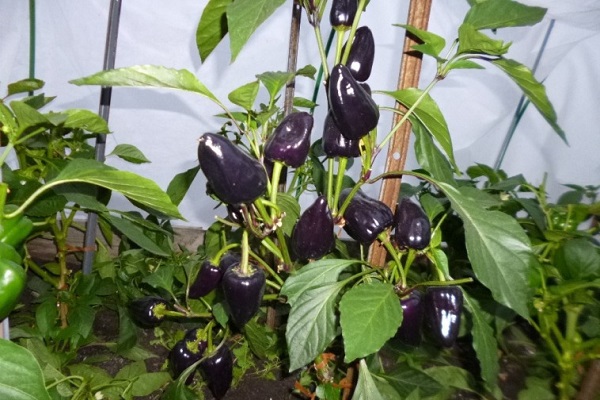
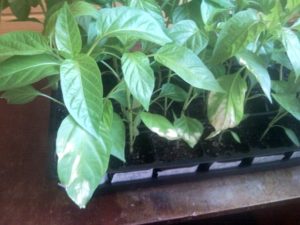
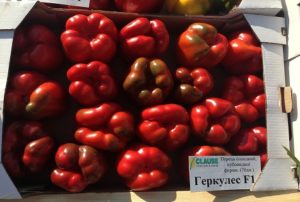
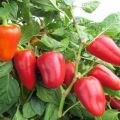
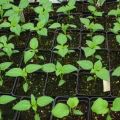


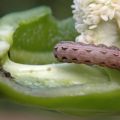
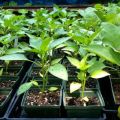
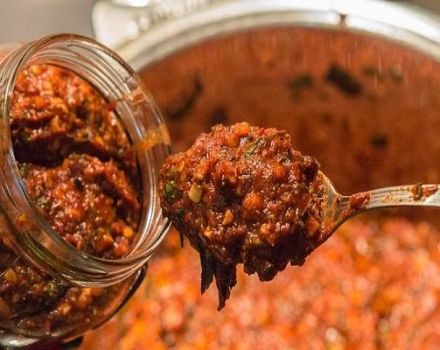
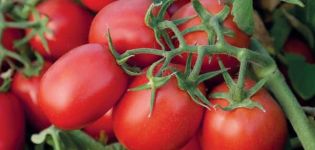
For the second year now I have been growing this kind of pepper, I fertilize the seedlings only with a bioactivator "BioGrow", So the pepper grows quite large. I really like the taste, I haven't noticed any flaws.